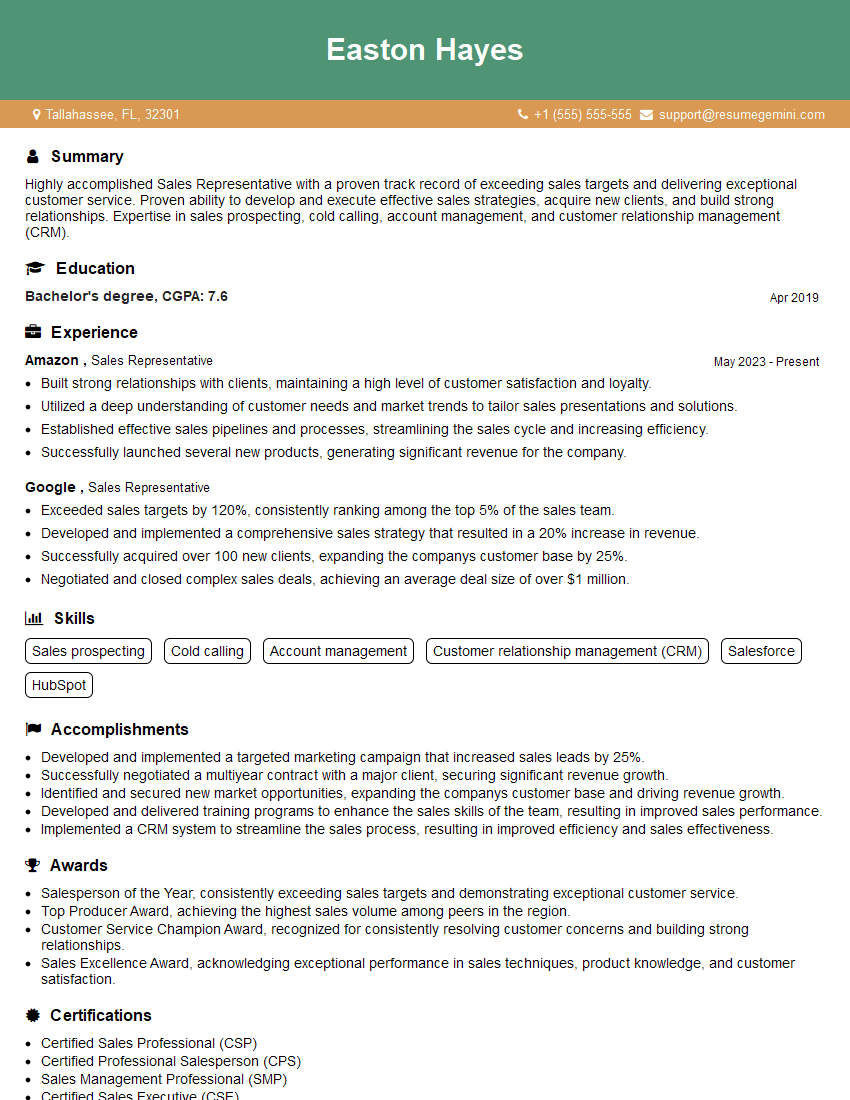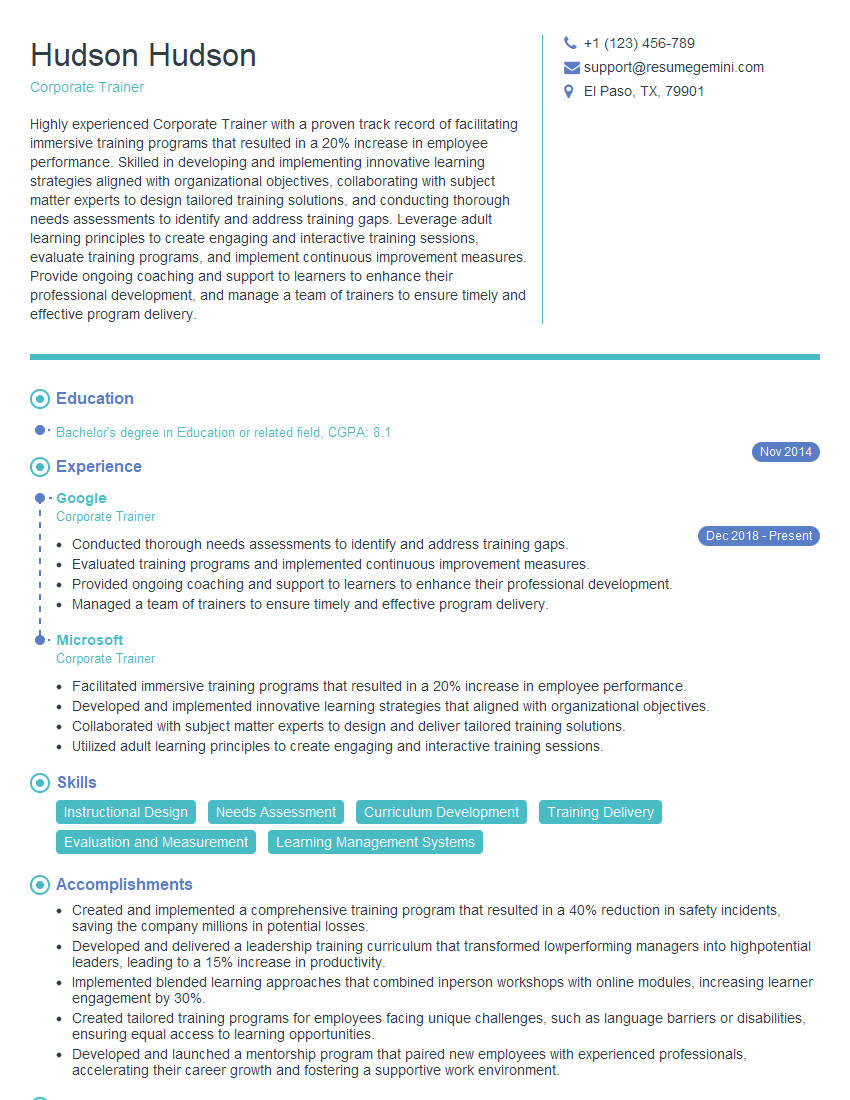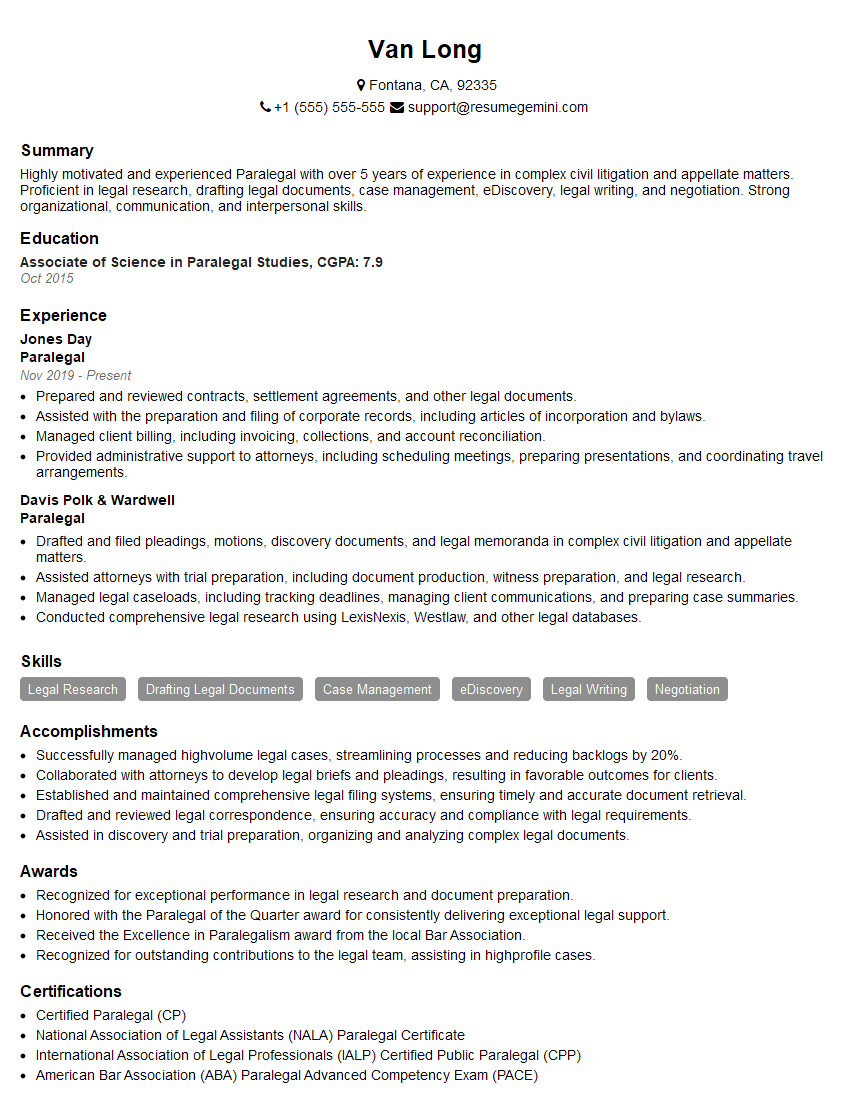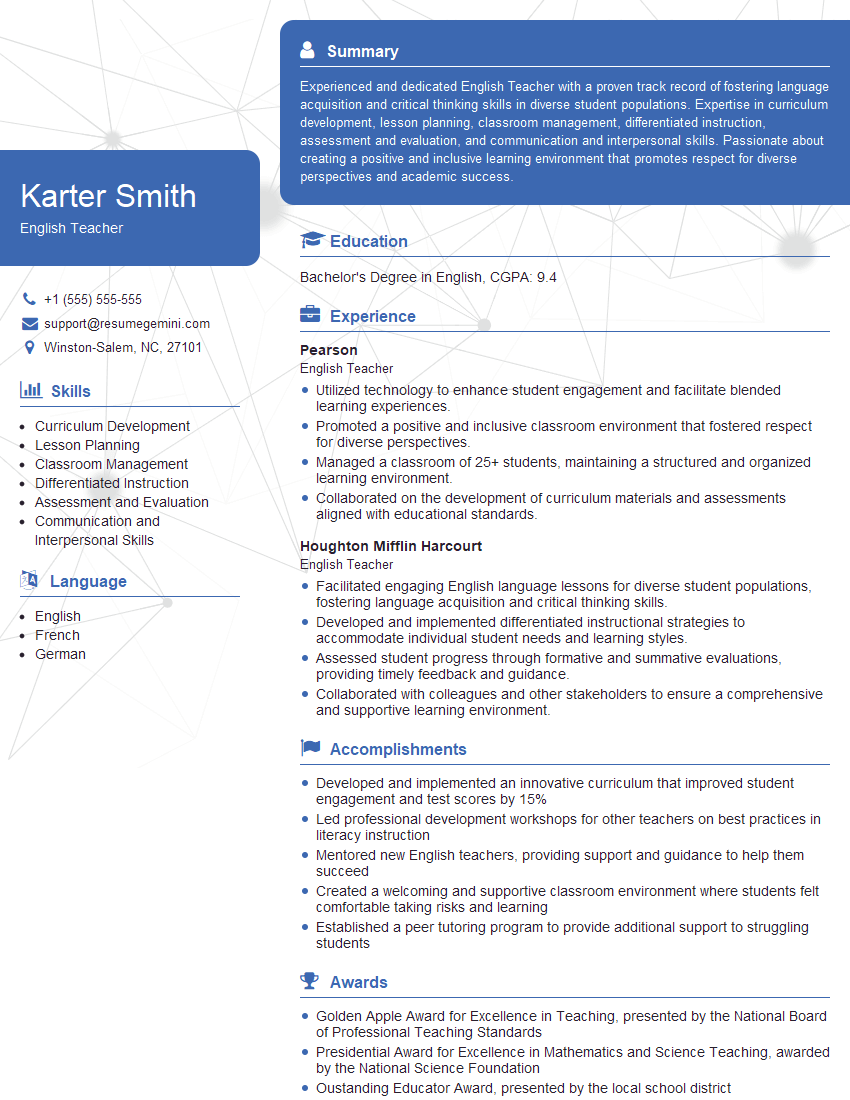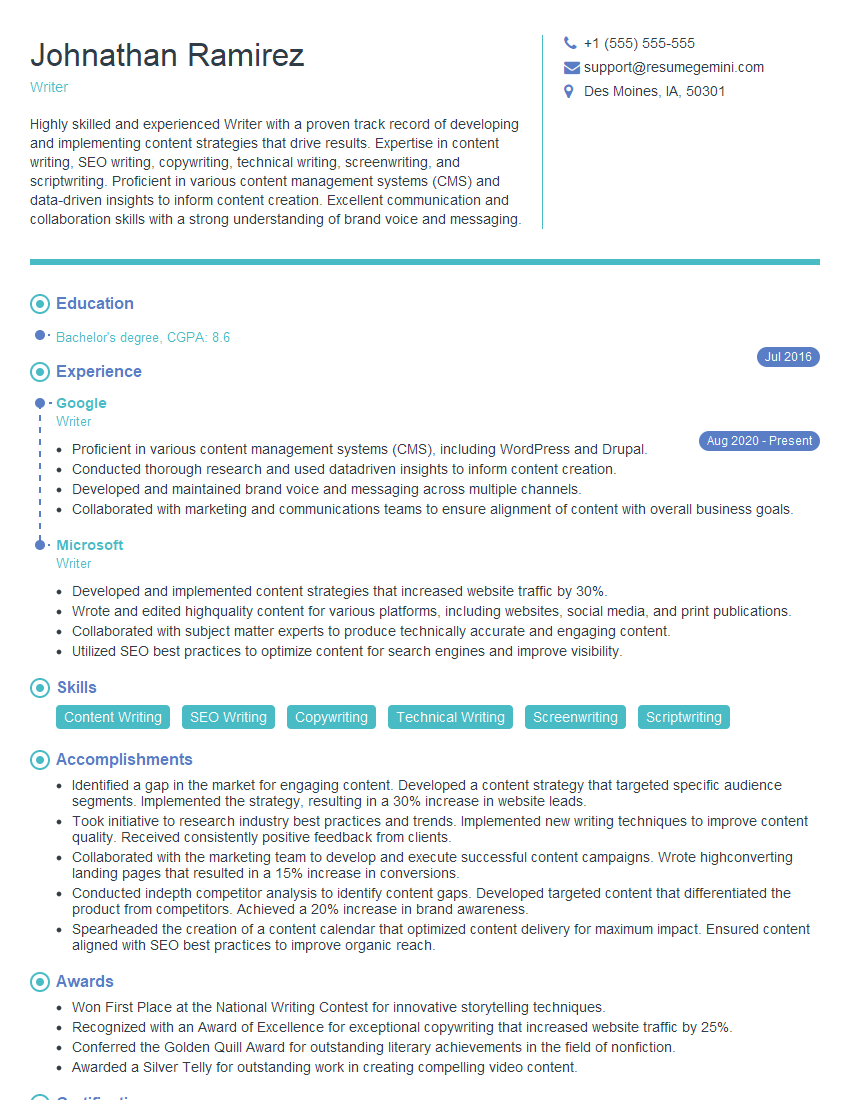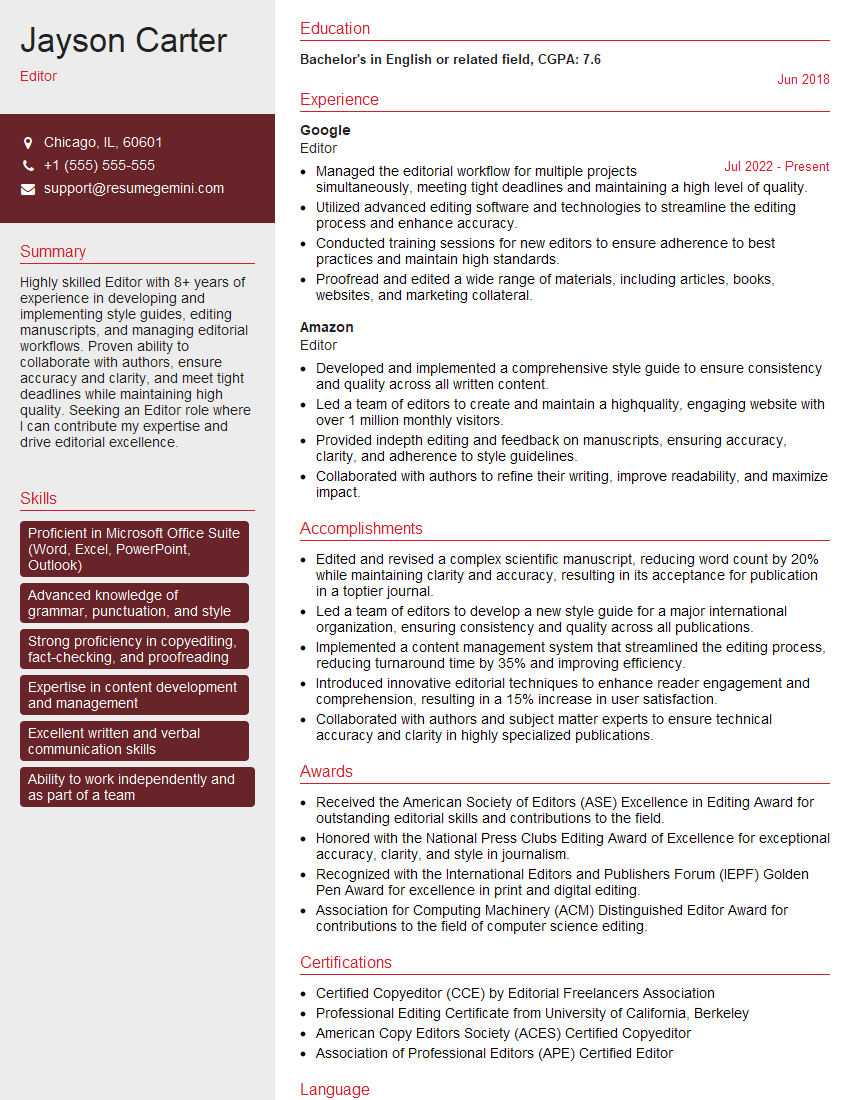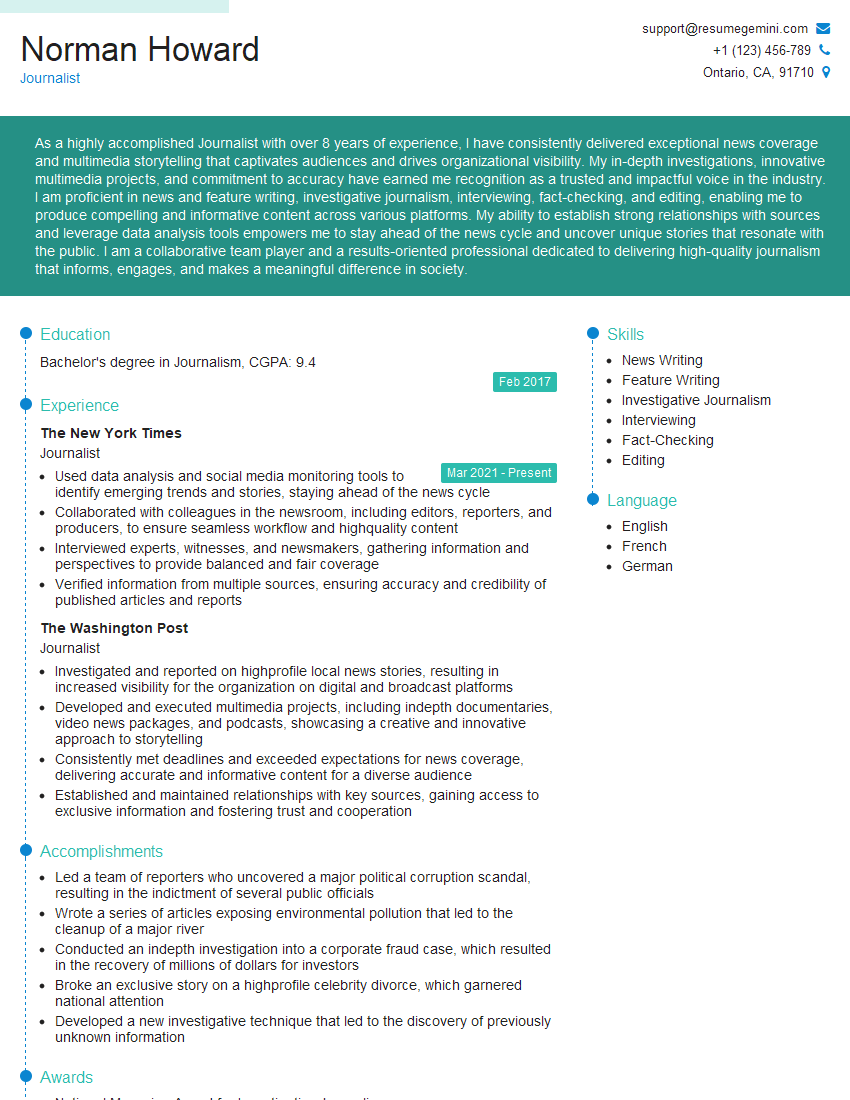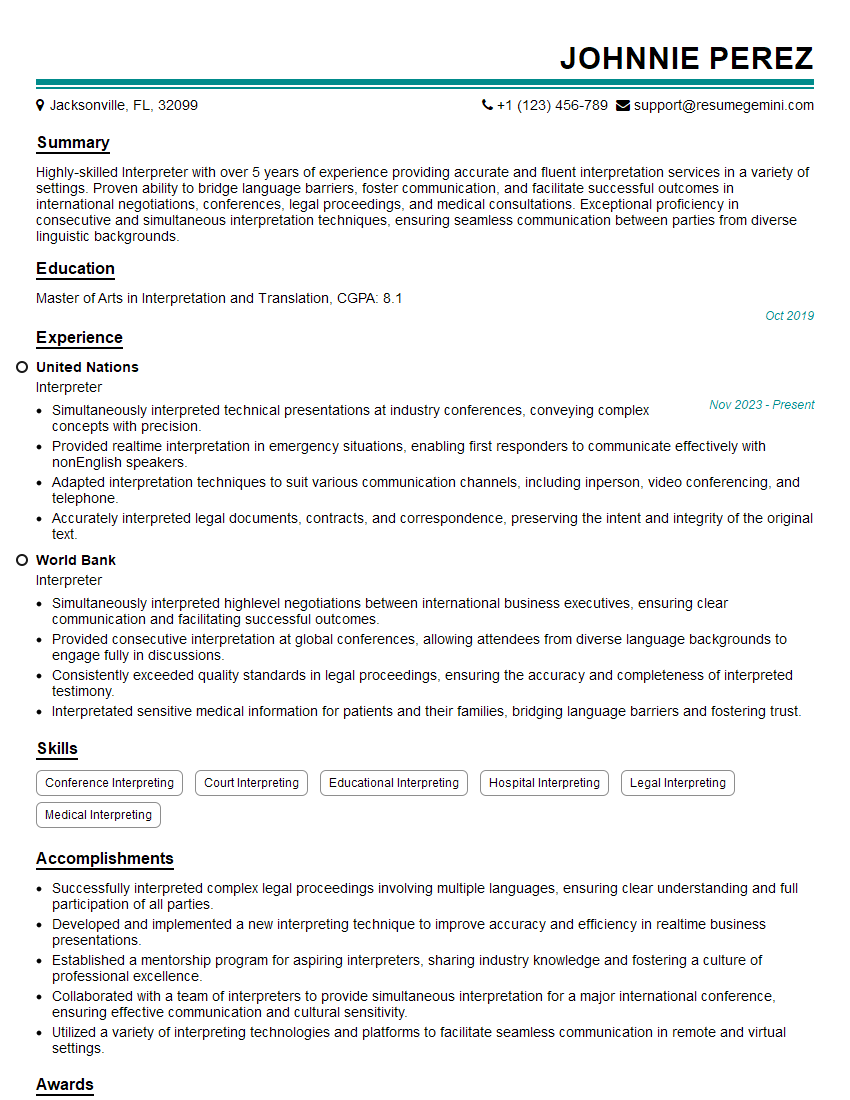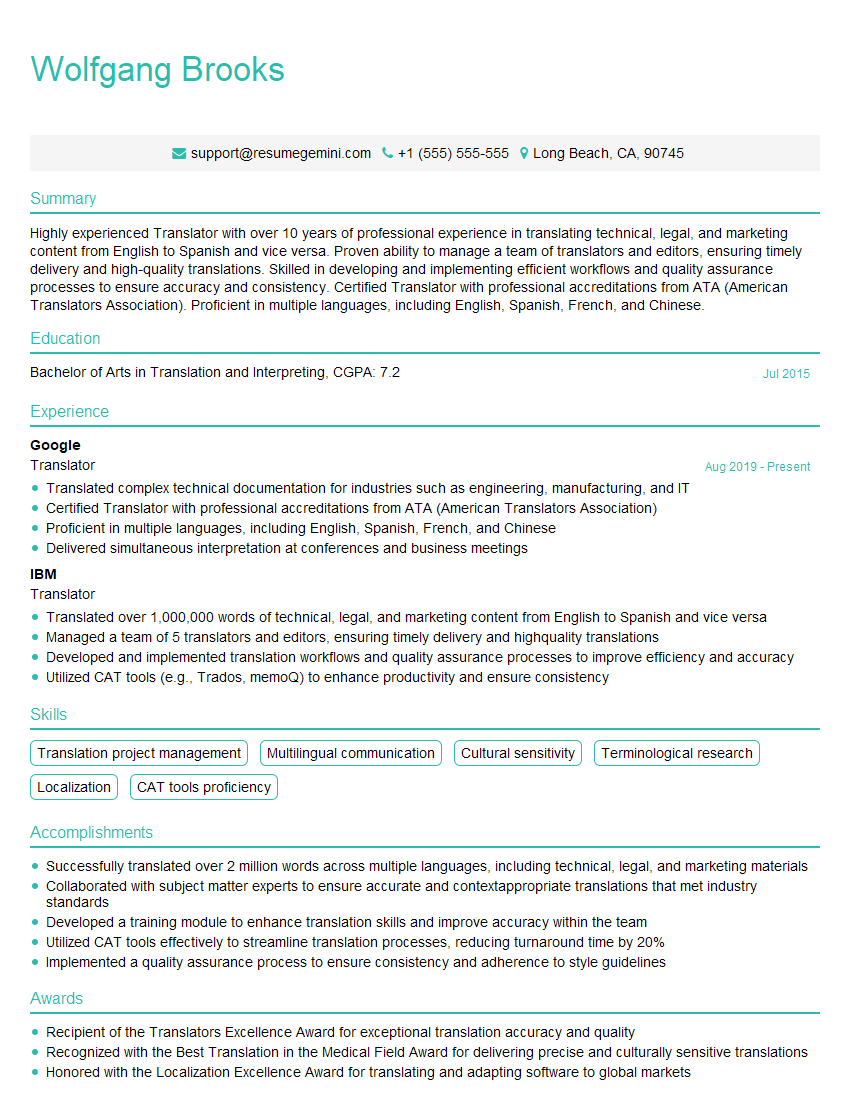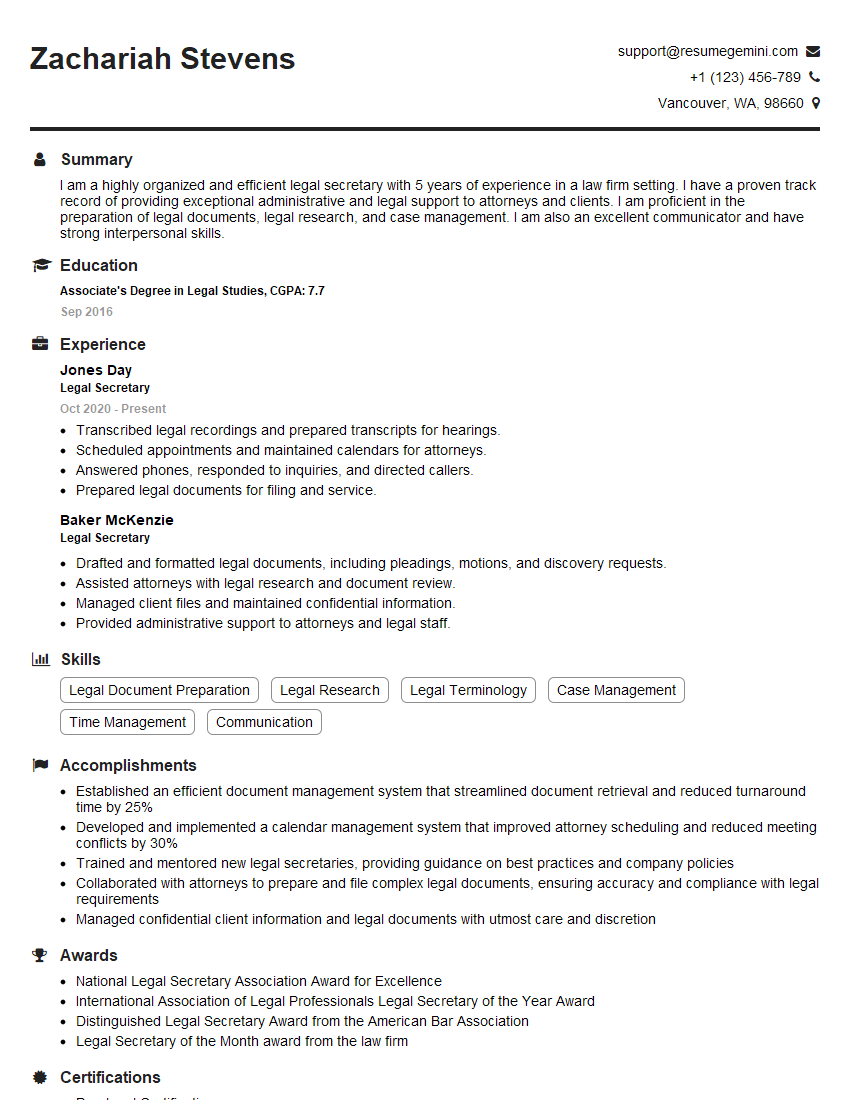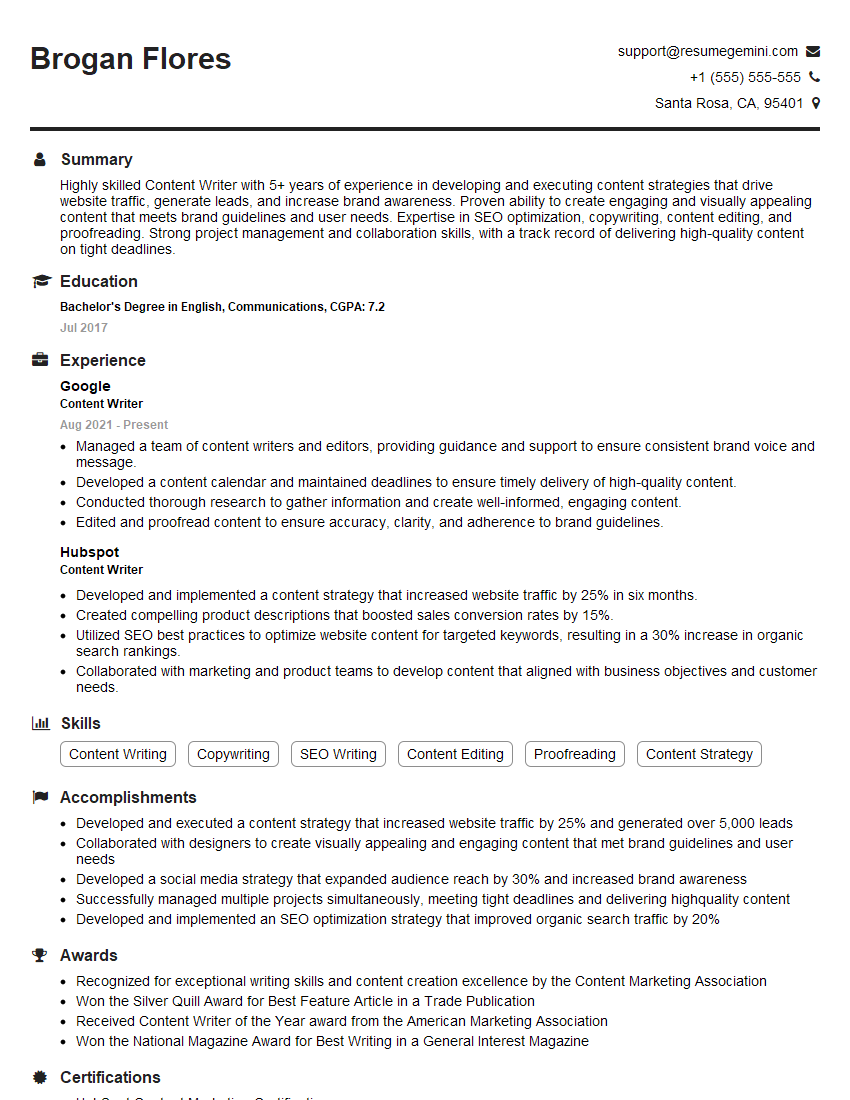Unlock your full potential by mastering the most common Fluent in English (written and verbal communication) interview questions. This blog offers a deep dive into the critical topics, ensuring you’re not only prepared to answer but to excel. With these insights, you’ll approach your interview with clarity and confidence.
Questions Asked in Fluent in English (written and verbal communication) Interview
Q 1. Describe your experience writing professional emails.
My experience with professional email writing encompasses crafting clear, concise, and impactful messages across various contexts. I prioritize a structured approach, starting with a compelling subject line that immediately conveys the email’s purpose. The body includes a brief introduction, a clear and focused message, a call to action, and a professional closing. I always proofread meticulously for grammar, spelling, and tone.
For example, when requesting information from a client, I’d use a subject line like “Project X: Data Request” instead of a vague subject like “Question.” I’d then clearly state my request, provide context, and specify a deadline. Finally, I’d express my gratitude for their time and assistance.
I’ve found this approach crucial in maintaining professional relationships and ensuring efficient communication. I adapt my tone and level of formality depending on the recipient – a more formal tone for senior management, and a more collaborative tone for colleagues.
Q 2. How would you handle a miscommunication with a colleague?
Miscommunications are inevitable, but how we handle them defines our professionalism. My approach begins with active listening and seeking to understand the colleague’s perspective. I’d avoid interrupting and ask clarifying questions to ensure complete comprehension of their point of view. Then, I’d clearly and calmly explain my perspective, highlighting any areas of misunderstanding.
For example, if a deadline was missed, I’d start by acknowledging the issue, and then we would jointly analyze the causes – were there resource constraints, unclear instructions, or other factors involved? Once the cause is identified, we’d collaborate on a solution and implement preventative measures for the future. I believe in open dialogue and collaborative problem-solving to prevent recurrence. Documentation of our discussion, with agreed-upon next steps, would follow to avoid further confusion.
Q 3. How do you ensure clarity and conciseness in your written communication?
Clarity and conciseness are paramount in effective written communication. I achieve this through several strategies. First, I carefully plan my message, outlining the key points before I begin writing. This prevents rambling and ensures a focused message. Secondly, I use simple language and avoid jargon unless absolutely necessary, and even then I provide clear definitions. Thirdly, I use short paragraphs and bullet points to enhance readability. Finally, I thoroughly proofread my work, eliminating unnecessary words and phrases.
For instance, instead of writing, “With regard to the aforementioned project, we have encountered certain unforeseen challenges that have resulted in a slight delay,” I would write, “We encountered unexpected challenges in Project X, causing a minor delay.” This is far more direct, simple, and less verbose.
Q 4. How would you adapt your communication style for different audiences?
Adapting communication style to different audiences is vital for effective messaging. I consider the audience’s background, technical expertise, and relationship with me when choosing my approach. For a senior executive, I’d use a formal, concise, and results-oriented style, focusing on key achievements and impact. With colleagues, I’d use a more collaborative, informal tone. For a non-technical audience, I’d avoid jargon and use analogies or relatable examples to clarify complex concepts.
Imagine explaining a complex financial model to a C-suite executive versus a new intern. The executive would appreciate a high-level overview focusing on key performance indicators and ROI, while the intern might need a detailed explanation of the underlying formulas and their implications.
Q 5. Explain a time you had to explain a complex technical concept to a non-technical audience.
I once had to explain a complex algorithm for data analysis to a group of marketing executives who lacked a technical background. Instead of diving into the intricate details of the code, I started by explaining the problem the algorithm solved – improving the accuracy of customer segmentation. I used simple analogies, like comparing the algorithm to a highly efficient sorting system, to make the concept relatable.
I then showed them visual representations of the data before and after the algorithm was applied, highlighting the significant improvements in accuracy and efficiency. I focused on the practical benefits and results instead of the underlying technical mechanisms. This approach allowed them to understand the algorithm’s value and its impact on their work without needing to grasp the technical complexities.
Q 6. How do you manage multiple communication tasks simultaneously?
Managing multiple communication tasks requires a structured approach. I employ a prioritization system, focusing on tasks with the most urgent deadlines or the highest impact first. I utilize tools like task management software and calendars to schedule and track my communication activities, setting realistic deadlines and allocating sufficient time for each task. I also practice effective time blocking to avoid distractions and maintain focus during dedicated communication periods.
I also batch similar tasks, like responding to emails, to improve efficiency. This means setting aside specific time slots to tackle related tasks, rather than switching between different tasks throughout the day, which can be disruptive and inefficient.
Q 7. Describe your approach to proofreading and editing your work.
My proofreading and editing approach involves a multi-step process. Firstly, I review my work for clarity, conciseness, and coherence, making sure the message is easily understood. Secondly, I check for grammar and spelling errors, using grammar and spell-check tools as an initial aid but not relying on them completely. Finally, I read the document aloud to catch any awkward phrasing or inconsistencies in tone.
I often leave time between writing and editing to allow for a fresh perspective. It’s surprising how many minor errors you can catch with fresh eyes. Sometimes I ask a colleague to review my work for a second opinion, ensuring different perspectives are incorporated before final submission.
Q 8. How proficient are you in different writing styles (e.g., formal, informal, persuasive)?
My proficiency in different writing styles is extensive. I adapt my approach based on the audience and purpose. Formal writing, as required for academic papers or business reports, demands precision, objectivity, and adherence to specific stylistic conventions. I ensure a clear structure, precise language, and a professional tone. Informal writing, suitable for internal communications or blog posts, allows for a more relaxed and conversational tone, but still maintains clarity and accuracy. Persuasive writing requires a deeper understanding of audience psychology, employing techniques like storytelling, logical reasoning, and emotional appeals to influence the reader. For example, I’ve written formal grant proposals for research funding, informal weekly team updates, and persuasive marketing copy for new product launches – each demanding a unique style and approach.
- Formal: I maintain objectivity, use precise language, and follow a structured format.
- Informal: I adopt a conversational tone while ensuring clarity and accuracy.
- Persuasive: I utilize storytelling, logical reasoning, and emotional appeals to influence the reader.
Q 9. Describe your experience giving presentations or public speaking.
I have extensive experience in presentations and public speaking, spanning various settings from small team meetings to large-scale conferences. I’ve presented research findings to academic peers, delivered product demos to potential clients, and conducted training sessions for diverse groups. My approach always emphasizes clear and concise messaging, engaging visuals, and interactive elements to maintain audience interest. I meticulously plan my presentations, ensuring a logical flow and addressing potential questions proactively. I’m comfortable adapting my style to different audiences and environments, adjusting my pace and tone to ensure maximum impact. For instance, a technical presentation to engineers would differ significantly from a marketing presentation to potential investors, requiring a nuanced understanding of the respective audience’s knowledge and interests.
I’m proficient in using presentation software like PowerPoint and Keynote to create visually appealing and effective slides. Beyond the technical aspects, I focus on establishing a strong rapport with the audience, utilizing non-verbal cues like eye contact and body language to enhance engagement.
Q 10. How do you handle difficult conversations or disagreements?
Handling difficult conversations or disagreements requires a combination of empathy, active listening, and strategic communication. My approach starts with ensuring a safe and respectful environment where all parties feel comfortable expressing their views. I actively listen to understand each person’s perspective, clarifying any misunderstandings through open-ended questions. Rather than focusing on assigning blame, I aim to identify the root cause of the disagreement. I facilitate collaborative problem-solving by exploring potential solutions together. My goal is to reach a mutually agreeable outcome, even if it involves compromise. If a complete resolution isn’t immediately possible, I establish clear next steps and timelines to ensure the issue is addressed effectively. For instance, I once mediated a conflict between two team members with differing approaches to a project. By actively listening to both sides and focusing on finding common ground, I helped them develop a collaborative solution that benefited the entire team.
Q 11. How do you ensure effective communication in a remote work setting?
Effective communication in a remote work setting relies heavily on proactive and clear communication strategies. Frequent and consistent communication is crucial. I use a variety of tools – instant messaging (Slack, Microsoft Teams), email, video conferencing (Zoom, Google Meet) – to ensure everyone is informed and connected. Asynchronous communication tools are vital for flexibility. I schedule regular virtual team meetings to maintain team cohesion and address any outstanding issues. I utilize project management software (Asana, Trello) to track progress, assign tasks, and maintain transparency. Clear documentation, including meeting minutes and project updates, is essential to avoid misunderstandings. I also place a strong emphasis on building relationships with colleagues even remotely, through virtual coffee breaks or informal online chats to foster a sense of camaraderie and shared purpose.
Q 12. What strategies do you use to improve your written communication skills?
I continually strive to improve my written communication skills through a multi-faceted approach. I regularly read widely, paying attention to style, structure, and clarity in different forms of writing. I seek constructive feedback on my writing from colleagues and mentors, carefully analyzing their comments to identify areas for improvement. I utilize online resources like grammar and style guides (Chicago Manual of Style, AP Stylebook) to refine my writing technique. I actively practice writing in different styles and contexts to expand my repertoire. I also utilize online tools like Grammarly to check for grammar and style errors. Furthermore, I consciously focus on clarity and conciseness, striving to communicate complex information in an accessible and understandable manner. For example, I regularly practice writing concise and effective emails, summarizing complex information into clear and actionable summaries.
Q 13. How would you handle feedback on your written or verbal communication?
I view feedback on my communication as an invaluable opportunity for growth. I approach feedback with an open mind, actively listening to the feedback giver’s perspective without becoming defensive. I clarify any points of confusion to ensure a complete understanding. I analyze the feedback to identify specific areas for improvement, focusing on actionable steps I can take to address those areas. I document the feedback and create a plan to implement the suggestions. I follow up with the feedback provider to demonstrate my commitment to improvement. For example, if I receive feedback that my presentations are too technical, I would plan to incorporate more visuals and simplify my language in future presentations. I would then follow up with the feedback provider to confirm the adjustments have been effective.
Q 14. Describe a situation where your communication skills helped you solve a problem.
In a previous role, a significant project faced delays due to a communication breakdown between different teams. Information wasn’t being shared effectively, leading to duplicated efforts and missed deadlines. I stepped in and implemented a structured communication plan. This involved establishing regular cross-team meetings, creating a shared online platform for document sharing and updates, and ensuring clear roles and responsibilities were defined. I also facilitated open discussions to address concerns and identify potential roadblocks. The result was a significant improvement in project coordination, enabling us to recover lost time and ultimately deliver the project successfully. This experience reinforced the crucial role of clear and proactive communication in complex projects and team collaborations.
Q 15. How familiar are you with different communication channels (email, phone, video conferencing)?
I’m highly proficient in using various communication channels, tailoring my approach to the specific context and audience. Email is ideal for formal communication, detailed information sharing, and maintaining a record. For instance, I use email to send project updates with comprehensive details and supporting documents. Phone calls are efficient for quick updates, brainstorming sessions, or when immediate feedback is required. A recent example involves using a phone call to address a client’s urgent query. Video conferencing, such as Zoom or Microsoft Teams, is perfect for collaborative discussions, presentations, or building rapport, particularly in remote work environments. I frequently utilize video conferencing for team meetings and client presentations, leveraging screen sharing to enhance collaboration.
- Email: Formal communication, detailed information, record-keeping.
- Phone: Urgent matters, quick updates, brainstorming, immediate feedback.
- Video Conferencing: Collaborative discussions, presentations, rapport building.
Career Expert Tips:
- Ace those interviews! Prepare effectively by reviewing the Top 50 Most Common Interview Questions on ResumeGemini.
- Navigate your job search with confidence! Explore a wide range of Career Tips on ResumeGemini. Learn about common challenges and recommendations to overcome them.
- Craft the perfect resume! Master the Art of Resume Writing with ResumeGemini’s guide. Showcase your unique qualifications and achievements effectively.
- Don’t miss out on holiday savings! Build your dream resume with ResumeGemini’s ATS optimized templates.
Q 16. How do you prioritize communication tasks effectively?
Prioritizing communication tasks involves a strategic approach that combines urgency, importance, and impact. I utilize a system that prioritizes tasks based on the Eisenhower Matrix (Urgent/Important). Urgent and Important tasks are tackled immediately (e.g., a client’s critical request). Important but not urgent tasks are scheduled (e.g., drafting a comprehensive report). Urgent but not important tasks are delegated if possible (e.g., responding to less critical emails). Tasks that are neither urgent nor important are eliminated or postponed. I also use tools like task management software to track deadlines and ensure timely completion. This ensures that critical communications are addressed promptly while less critical ones are managed efficiently.
Q 17. Can you describe your experience using grammar and style guides?
My experience with grammar and style guides is extensive. I’m intimately familiar with the Chicago Manual of Style, AP Stylebook, and various other style guides depending on the context. I use these guides to ensure consistency in grammar, punctuation, tone, and style, adapting my writing to suit the specific audience and publication. For example, a formal report requires adherence to the Chicago Manual of Style, whereas a blog post might benefit from a more relaxed, AP style. I regularly review my work for grammatical errors and stylistic inconsistencies, utilizing tools like Grammarly to assist in this process, though I always maintain a critical eye for nuance and context, recognizing that style guides offer guidelines, not inflexible rules.
Q 18. Describe a time you had to deliver bad news effectively.
I once had to deliver bad news to a team regarding a project delay. I chose to communicate this information in a face-to-face meeting, acknowledging the negative impact upfront, but focusing on transparency and problem-solving. I explained the reasons for the delay honestly and directly, avoiding jargon or overly technical language. Crucially, I presented a revised timeline and a plan to mitigate further delays, emphasizing our commitment to the project’s success. I also ensured an open forum for questions and concerns, allowing team members to express their feelings and fostering a collaborative approach to overcoming the challenge. The key was to be empathetic, transparent, and solution-oriented, rather than simply delivering the negative news without context or plan.
Q 19. How do you ensure your written communication is free of bias?
Ensuring my written communication is free of bias requires conscious effort and critical self-reflection. I actively avoid gendered language, using inclusive terms like ‘they’ or restructuring sentences to avoid gendered pronouns when the gender is unknown. I also avoid stereotypes and generalizations about any group of people. I strive to use language that is objective and data-driven, basing my arguments on facts rather than assumptions or personal opinions. Regularly reviewing my writing from the perspective of different readers – considering potential biases – is crucial. For example, I might ask a colleague from a different background to review my work for any unintentional biases I may have overlooked.
Q 20. What tools or software do you use to support your communication efforts?
My communication efforts are supported by several tools. For writing and editing, I rely on Grammarly and ProWritingAid for grammar and style checks. For project management and task tracking, I use Asana or Trello. For video conferencing, I utilize Zoom and Microsoft Teams. I’m also proficient in using various productivity software such as Google Workspace and Microsoft Office suite for document creation and collaboration. Furthermore, I often employ specialized tools depending on the project, such as social media analytics platforms or CRM systems for client communication.
Q 21. How do you maintain professionalism in your communication?
Maintaining professionalism in communication involves several key aspects. Firstly, clarity and conciseness are paramount. I avoid ambiguity and unnecessary jargon, ensuring my message is easily understood. Secondly, I always maintain a respectful and courteous tone, even when addressing challenging situations. Thirdly, I ensure timely responses and meet deadlines consistently. Finally, I pay attention to detail, proofreading all written communication carefully. Professionalism also extends to my online presence and how I represent myself in digital spaces. I adhere to professional etiquette in all online interactions, ensuring my communication reflects positively on myself and my organization.
Q 22. How do you use active listening to improve communication?
Active listening isn’t just hearing words; it’s fully engaging with the speaker to understand their message completely. It involves paying attention to both verbal and nonverbal cues, asking clarifying questions, and providing feedback to ensure understanding.
- Paying Attention: Minimize distractions, maintain eye contact (appropriately), and focus on the speaker’s words and body language.
- Showing Engagement: Use nonverbal cues like nodding, leaning in, and maintaining open posture to show you’re actively listening. Verbal cues like “uh-huh” or “I understand” can also be helpful, but avoid interrupting.
- Asking Clarifying Questions: If something is unclear, don’t hesitate to ask for clarification. Phrases like “Can you elaborate on that?” or “I want to make sure I understand, so you’re saying…” are useful.
- Providing Feedback: Summarize or paraphrase what the speaker said to confirm your understanding. For example, “So, if I understand correctly, you’re saying…”
For example, in a client meeting, active listening helps ensure I understand their needs before proposing solutions. By asking clarifying questions and summarizing their concerns, I build trust and avoid misunderstandings that could lead to project delays or dissatisfaction.
Q 23. Describe a time your communication skills failed you. What did you learn?
During a crucial project presentation, my nerves got the better of me. I rushed through key details, neglecting to explain complex aspects clearly. The audience’s questions revealed a significant gap in their understanding, highlighting my failure to tailor my communication to their level of knowledge. The project, while ultimately successful, suffered from initial confusion and required extra time for clarification.
The learning experience was invaluable. I realized the importance of audience analysis—understanding their background and anticipating their questions beforehand. I learned to practice my presentation thoroughly, incorporating visual aids and focusing on clear, concise language. I also improved my ability to handle unexpected questions gracefully, acknowledging uncertainty where necessary and committing to finding answers promptly.
Q 24. How do you assess the effectiveness of your communication?
Assessing communication effectiveness is an ongoing process, not a single event. I use a multi-pronged approach:
- Immediate Feedback: Observing the audience’s reactions during a presentation or conversation (body language, questions asked). Did they seem engaged and understanding?
- Post-Communication Follow-up: Sending a follow-up email after a meeting to clarify key points or confirm action items. This allows me to gauge if the message was received and understood correctly.
- Data Analysis: For larger-scale communications, analyzing metrics such as email open rates, website traffic, or survey results provides quantifiable data on effectiveness.
- Seeking Feedback: Directly soliciting feedback from colleagues or clients helps identify areas for improvement. Asking open-ended questions like “What could I have done differently?” is crucial.
For instance, after a training session, I might distribute a short survey asking participants to rate their understanding of the material and suggest improvements. This data, combined with my observations during the session, paints a clear picture of the communication’s effectiveness.
Q 25. How do you handle communication breakdowns?
Communication breakdowns are inevitable, but how we handle them defines our communication skills. My approach involves:
- Identifying the Root Cause: Was the message unclear? Was there a language barrier? Were there conflicting priorities or misunderstandings?
- Open and Honest Dialogue: Approaching the other party with empathy and a willingness to understand their perspective. Creating a safe space for open communication is vital.
- Active Listening and Clarification: Employing active listening techniques to ensure everyone fully understands each other’s point of view. Clarifying ambiguities and seeking consensus are crucial.
- Finding Common Ground: Focusing on shared goals and finding solutions that address everyone’s needs.
- Documenting Agreements: Summarizing the agreed-upon actions and distributing them to all parties involved to avoid future misunderstandings.
For instance, if a project deadline is missed due to a communication gap, I’d initiate a meeting to discuss what led to the delay, acknowledge the impact, and collaboratively create a revised plan, ensuring clear communication going forward.
Q 26. How would you summarize a complex report in a concise and engaging manner?
Summarizing a complex report concisely and engagingly requires a strategic approach:
- Identify Key Findings: Start by identifying the 2-3 most crucial findings or recommendations. These are the takeaways you want the audience to remember.
- Use Visual Aids: Charts, graphs, or even a simple table can dramatically enhance understanding and engagement. A picture is often worth a thousand words.
- Storytelling Approach: Frame the findings within a narrative. Begin with a compelling hook, then present the data logically, leading to a clear conclusion.
- Keep it Concise: Avoid jargon and overly technical language. Use short, declarative sentences, and focus on clarity.
- Practice Delivery: Rehearse your summary to ensure a smooth and confident delivery. Timing is important; aim for brevity while ensuring all key points are covered.
For example, if summarizing a lengthy market research report, I’d focus on the key trends affecting the target market, the most impactful findings, and the resulting recommendations. I might use a graph to visualize market share changes and then concisely explain the implications for business strategy.
Q 27. What are your strengths and weaknesses in written communication?
Strengths: I excel at clarity and conciseness in my writing. I’m adept at structuring documents logically, using headings and subheadings to enhance readability. I can adapt my writing style to suit the audience and purpose (formal reports vs. informal emails). I am also proficient in using various writing tools and software (e.g., grammar checkers, style guides).
Weaknesses: My writing can sometimes be too formal or overly cautious. I’m actively working on improving my creativity and incorporating more engaging storytelling techniques into my written communication.
Q 28. What are your strengths and weaknesses in verbal communication?
Strengths: I’m confident and articulate in my verbal communication. I can adapt my communication style to different audiences and situations. I actively listen and respond thoughtfully, ensuring mutual understanding. I’m comfortable presenting information effectively in both formal and informal settings.
Weaknesses: I occasionally struggle to maintain a balance between being concise and providing sufficient detail when speaking. I’m actively working on improving my ability to handle difficult conversations and manage interruptions effectively.
Key Topics to Learn for Fluent in English (written and verbal communication) Interview
- Articulate Complex Ideas Concisely: Mastering the ability to explain technical concepts or project details clearly and succinctly, avoiding jargon where inappropriate.
- Active Listening and Responding: Demonstrate attentive listening skills by paraphrasing questions and providing thoughtful, relevant answers. Practice responding to both anticipated and unexpected interview questions.
- Nonverbal Communication: Understand the impact of body language, eye contact, and tone of voice on conveying confidence and professionalism during interviews.
- Professional Written Communication: Practice crafting clear, concise, and grammatically correct emails, cover letters, and other written communication. Focus on adapting your writing style to different audiences and purposes.
- Handling Difficult Questions: Develop strategies for addressing challenging interview questions with grace and composure. Practice structuring your responses to highlight your strengths and address any potential concerns.
- Storytelling and Examples: Prepare compelling anecdotes that showcase your skills and experiences using the STAR method (Situation, Task, Action, Result) to illustrate your points effectively.
- Interview Structure and Etiquette: Familiarize yourself with common interview formats (behavioral, technical, panel) and appropriate interview etiquette, including punctuality and professional attire (even for virtual interviews).
Next Steps
Fluency in English, both written and verbal, is paramount for career advancement in today’s globalized world. It opens doors to a wider range of opportunities and allows you to communicate your skills and value effectively. Creating an ATS-friendly resume is crucial for maximizing your job prospects; it ensures your application gets noticed by recruiters and hiring managers. To build a compelling and effective resume, leverage the power of ResumeGemini. ResumeGemini provides the tools and resources you need to craft a professional document that showcases your unique qualifications. Examples of resumes tailored to highlight fluency in English (written and verbal communication) are available to help guide your resume building process.
Explore more articles
Users Rating of Our Blogs
Share Your Experience
We value your feedback! Please rate our content and share your thoughts (optional).
What Readers Say About Our Blog
Interesting Article, I liked the depth of knowledge you’ve shared.
Helpful, thanks for sharing.
Hi, I represent a social media marketing agency and liked your blog
Hi, I represent an SEO company that specialises in getting you AI citations and higher rankings on Google. I’d like to offer you a 100% free SEO audit for your website. Would you be interested?


